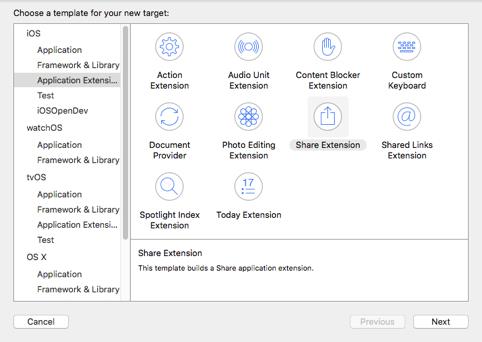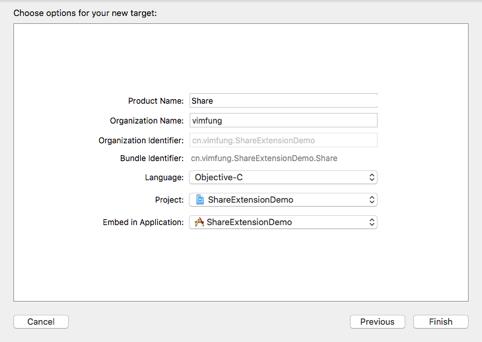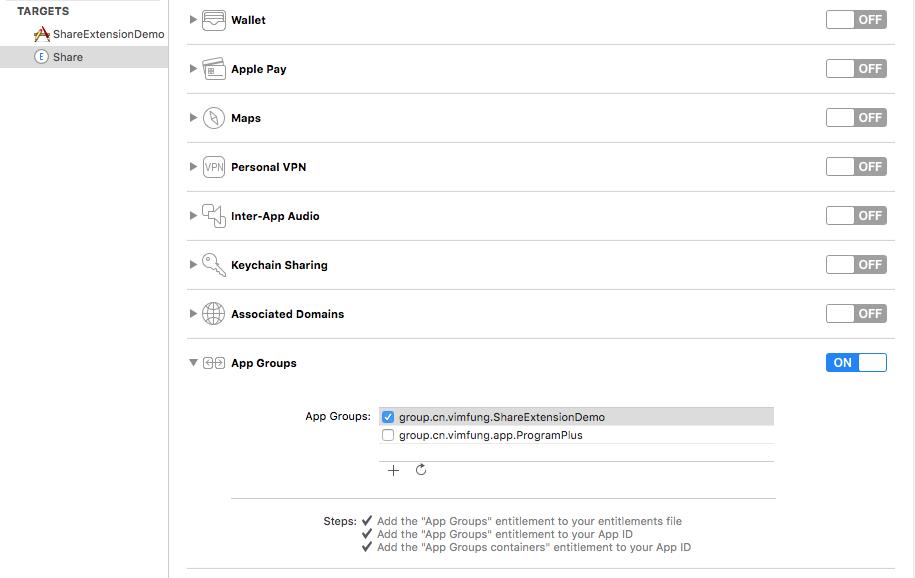iOS扩展开发攻略Share Extension
Posted 杰嗒嗒的阿杰
tags:
篇首语:本文由小常识网(cha138.com)小编为大家整理,主要介绍了iOS扩展开发攻略Share Extension相关的知识,希望对你有一定的参考价值。
【ios扩展开发攻略】Share Extension
- 1. 什么是扩展?
- 2. 转入正题 - Share Extension
- 3. 进阶研究
- 3.2 替换Share Extension中的默认分享界面
- 4. ShareExtension相关问题
- 5. 相关文章
1. 什么是扩展?
扩展( Extension )是 iOS 8 中引入的一个非常重要的新特性。扩展让 app 之间的数据交互成为可能。用户可以在 app 中使用其他应用提供的功能,而无需离开当前的应用。在 iOS 8 系统之前,每一个 app 在物理上都是彼此独立的, app 之间不能互访彼此的私有数据。而在引入扩展之后,其他 app 可以与扩展进行数据交换。基于安全和性能的考虑,每一个扩展运行在一个单独的进程中,它拥有自己的 bundle , bundle 后缀名是.appex 。扩展 bundle 必须包含在一个普通应用的 bundle 的内部。
iOS 8 系统有 6 个支持扩展的系统区域,分别是 Today 、 Share 、 Action 、 Photo Editing 、 Storage Provider 、 Custom keyboard 。支持扩展的系统区域也被称为扩展点。
Today Widget
对于赛事比分,股票、天气、快递这类需要实时获取的信息,可以在通知中心的Today 视图中创建一个 Today 扩展实现。 Today 扩展又称为 Widget 。

Share
在 iOS 8 之前,用户只有 Facebook,Twitter 等有限的几个分享选项可以选择。如果希望将内容分享到 Pinterest ,开发者则需要一些额外的努力。在 iOS 8 中,开发者可以创建自定义的分享选项。

Action
action 在所有支持的扩展点中扩展性最强的一个。它可以实现转换另一个 app 上下文中的内容。苹果在 WWDC 大会上演示了一个 Bing 翻译动作扩展,它可以将在 Safari 中选中的文本翻译成不同的语言。

Photo Editing
在 iOS 8 之前,如果你想为你的照片添加一个特殊的滤镜,你需要进入第三方 app 中,这个过程是相当繁琐的。在 iOS 8 中,你可以直接在 Photos 中使用第三方 app ,如 Instagram , VSCO cam 、 Aviary 提供的 Photo Editing 扩展完成对图片的编辑,而无需离开当前的 app 。

Storage Provider
Storage Provider 让跨多个文件存储服务之间的管理变得更简单。类似 Dropbox 、 Google Drive 等存储提供商通过在 iOS 8 中提供一个 Storage Provider 扩展, app 直接可以使用这些扩展检索和存储文件而不再需要创建不必要的拷贝。

Custom Keyboard
苹果公司在 2007 年率先推出了触摸屏键盘,但一直没多大改进。在这一方面, android 则将键盘权限开放给了第三方开发者,所以出现了许多像 Swype , SwiftKey 等优秀的键盘输入法。在 iOS 8 中,苹果终于将键盘权限开发给了第三方开发者,自定义键盘输入法可以让用户在整个系统范围内使用。

以下是iOS 9中新增扩展
网络扩展
开发者可以通过改扩展来实现自定义的VPN客户端、透明的网络代理客户端以及实现动态的设备端网络内容过滤。
Safari扩展
该扩展可以让用户通过Safari的分享链接看到你的内容。又或者提供一个屏蔽列表,让你的用户使用你的App浏览Web内容时屏蔽指定的内容。
Spotlight扩展
该扩展可以对App内的数据进行索引,并且可以在不重启App的情况下重建数据索引。
Audio Unit扩展
该扩展允许App提供类似于GarageBand,Logic等App提供的乐器演奏,音频特效,声音合成功能。
2. 转入正题 - Share Extension
本篇文章主要是探讨Share Extension的开发与使用。下面会结合一个例子对其做一个全面的探讨和深入的了解。
2.1 创建Share Extension扩展Target
** 注:扩展不能单独创建,必须依赖于应用工程项目,因此如果你还没有创建一个应用工程,先去创建一个。**
1、打开项目设置,在TARGETS侧栏地下点击“+”号来创建一个新的Target,如图:

2、然后选择”iOS” -> “Application Extension” -> “Share Extension”,点击“Next”。如图:

3、给扩展起个名字,这里填写了“Share”,点击“Finish”。如图:

4、这时候会提示创建一个Scheme,点击“Activate”。如图:

那么,直到这里创建Share Extension的工作就算是完成了。接下来可以先进行一下编译运行。这里跟做App开发的时候会稍微有点不一样。因为Extension是需要Host App(宿主应用)来运行的。所以,XCode中会弹出界面让我们选择一个iOS的App来运行Extension。如图:

这里我选择了XCode建议的应用Safari,然后点击“Run”来进行调试运行。XCode会启动Safari,如图:

能看到Safari中间的分享按钮是灰色不可用的。别急,你还没打开一个网页呢_。我们随便点开一个网页,可以看到分享按钮变为激活状态。点击分享按钮就会弹出分享菜单,如图:

可以看到刚才建立的Share扩展已经显示在面板上了,如果你没有发现自己的扩展,那么你可以将菜单滑动到最右边,在“更多”选项中激活自己的扩展。如图:

我们点击自己创建的分享项,其弹出一个分享窗口。如图:

2.2. 配置Share Extension
接下来我们需要给他一些设置。我们展开XCode左侧栏的Share目录,找到Info.plist文件。如:

我们只需要关注以下几个字段的设置:
| 名称 | 说明 |
|---|---|
| Bundle display name | 扩展的显示名称,默认跟你的项目名称相同,可以通过修改此字段来控制扩展的显示名称。 |
| NSExtension | 扩展描述字段,用于描述扩展的属性、设置等。作为一个扩展项目必须要包含此字段。 |
| NSExtensionAttributes | 扩展属性集合字段。用于描述扩展的属性。 |
| NSExtensionActivationRule | 激活扩展的规则。默认为字符串“TRUEPREDICATE”,表示在分享菜单中一直显示该扩展。可以将类型改为Dictionary类型,然后添加以下字段: NSExtensionActivationSupportsAttachmentsWithMaxCount NSExtensionActivationSupportsAttachmentsWithMinCount NSExtensionActivationSupportsImageWithMaxCount NSExtensionActivationSupportsMovieWithMaxCount NSExtensionActivationSupportsWebPageWithMaxCount NSExtensionActivationSupportsWebURLWithMaxCount |
| NSExtensionMainStoryboard | 设置主界面的Storyboard,如果不想使用storyboard,也可以使用NSExtensionPrincipalClass指定自定义UIViewController子类名 |
| NSExtensionPointIdentifier | 扩展标识,在分享扩展中为:com.apple.share-services |
| NSExtensionPrincipalClass | 自定义UI的类名 |
| NSExtensionActivationSupportsAttachmentsWithMaxCount | 附件最多限制,为数值类型。附件包括File、Image和Movie三大类,单一、混选总量不超过指定数量 |
| NSExtensionActivationSupportsAttachmentsWithMinCount | 附件最少限制,为数值类型。当设置NSExtensionActivationSupportsAttachmentsWithMaxCount时生效,默认至少选择1个附件,分享菜单中才显示扩展插件图标。 |
| NSExtensionActivationSupportsFileWithMaxCount | 文件最多限制,为数值类型。文件泛指除Image/Movie之外的附件,例如【邮件】附件、【语音备忘录】等。 单一、混选均不超过指定数量。 |
| NSExtensionActivationSupportsImageWithMaxCount | 图片最多限制,为数值类型。单一、混选均不超过指定数量。 |
| NSExtensionActivationSupportsMovieWithMaxCount | 视频最多限制,为数值类型。单一、混选均不超过指定数量。 |
| NSExtensionActivationSupportsText | 是否支持文本类型,布尔类型,默认不支持。如【备忘录】的分享 |
| NSExtensionActivationSupportsWebURLWithMaxCount | Web链接最多限制,为数值类型。默认不支持分享超链接,需要自己设置一个数值。 |
| NSExtensionActivationSupportsWebPageWithMaxCount | Web页面最多限制,为数值类型。默认不支持Web页面分享,需要自己设置一个数值。 |
对于不同的应用里面有可能出现只允许接受某种类型的内容,那么Share Extension就不能一直出现在分享菜单中,因为不同的应用提供的分享内容不一样,这就需要通过设置NSExtensionActivationRule字段来决定Share Extension是否显示。例如,只想接受其他应用分享链接到自己的应用,那么可以通过下面的步骤来设置:
- 将NSExtensionActivationRule字段类型由String改为Dictionary。
- 展开NSExtensionActivationRule字段,创建其子项NSExtensionActivationSupportsWebURLWithMaxCount,并设置一个限制数量。
调整后如下图所示:

2.3 处理Share Extension中的数据
其实在Share Extension中默认都会有一个数据展现的UI界面。该界面继承SLComposeServiceViewController这个类型,如:
@interface ShareViewController : SLComposeServiceViewController
@end
其展现效果,如图:

顶部包括了标题、取消(Cancel)按钮和提交(Post)按钮。然后下面跟着左边就是一个文本编辑框,右边就是一个图片显示控件。那么,每当用户点击取消按钮或者提交按钮时,都会分别触发下面的方法:
/**
* 点击取消按钮
*/
- (void)didSelectCancel
[super didSelectCancel];
/**
* 点击提交按钮
*/
- (void)didSelectPost
// This is called after the user selects Post. Do the upload of contentText and/or NSExtensionContext attachments.
// Inform the host that we're done, so it un-blocks its UI. Note: Alternatively you could call super's -didSelectPost, which will similarly complete the extension context.
[self.extensionContext completeRequestReturningItems:@[] completionHandler:nil];
在这两个方法里面可以进行一些自定义的操作。一般情况下,当用户点击提交按钮的时候,扩展要做的事情就是要把数据取出来,并且放入一个与Containing App(** 容器程序,尽管苹果开放了Extension,但是在iOS中extension并不能单独存在,要想提交到AppStore,必须将Extension包含在一个App中提交,并且App的实现部分不能为空,这个包含Extension的App就叫Containing app。Extension会随着Containing App的安装而安装,同时随着ContainingApp的卸载而卸载。**)共享的数据介质中(包括NSUserDefault、Sqlite、CoreData),要跟容器程序进行数据交互需要借助AppGroups服务,下面的章节会对这块进行详细说明。下面先来看看怎么获取扩展中的数据。
在ShareExtension中,UIViewController包含一个extensionContext这样的上下文对象:
@interface UIViewController(NSExtensionAdditions) <NSExtensionRequestHandling>
// Returns the extension context. Also acts as a convenience method for a view controller to check if it participating in an extension request.
@property (nullable, nonatomic,readonly,strong) NSExtensionContext *extensionContext NS_AVAILABLE_IOS(8_0);
@end
通过操作它就可以获取到分享的数据,返回宿主应用的界面等操作。我们可以先看一下extensionContext的定义。
NS_CLASS_AVAILABLE(10_10, 8_0)
@interface NSExtensionContext : NSObject
// The list of input NSExtensionItems associated with the context. If the context has no input items, this array will be empty.
@property(readonly, copy, NS_NONATOMIC_IOSONLY) NSArray *inputItems;
// Signals the host to complete the app extension request with the supplied result items. The completion handler optionally contains any work which the extension may need to perform after the request has been completed, as a background-priority task. The `expired` parameter will be YES if the system decides to prematurely terminate a previous non-expiration invocation of the completionHandler. Note: calling this method will eventually dismiss the associated view controller.
- (void)completeRequestReturningItems:(nullable NSArray *)items completionHandler:(void(^ __nullable)(BOOL expired))completionHandler;
// Signals the host to cancel the app extension request, with the supplied error, which should be non-nil. The userInfo of the NSError will contain a key NSExtensionItemsAndErrorsKey which will have as its value a dictionary of NSExtensionItems and associated NSError instances.
- (void)cancelRequestWithError:(NSError *)error;
// Asks the host to open an URL on the extension's behalf
- (void)openURL:(NSURL *)URL completionHandler:(void (^ __nullable)(BOOL success))completionHandler;
@end
// Key in userInfo. Value is a dictionary of NSExtensionItems and associated NSError instances.
FOUNDATION_EXTERN NSString * __null_unspecified const NSExtensionItemsAndErrorsKey NS_AVAILABLE(10_10, 8_0);
// The host process will enter the foreground
FOUNDATION_EXTERN NSString * __null_unspecified const NSExtensionHostWillEnterForegroundNotification NS_AVAILABLE_IOS(8_2);
// The host process did enter the background
FOUNDATION_EXTERN NSString * __null_unspecified const NSExtensionHostDidEnterBackgroundNotification NS_AVAILABLE_IOS(8_2);
// The host process will resign active status (stop receiving events), the extension may be suspended
FOUNDATION_EXTERN NSString * __null_unspecified const NSExtensionHostWillResignActiveNotification NS_AVAILABLE_IOS(8_2);
// The host process did become active (begin receiving events)
FOUNDATION_EXTERN NSString * __null_unspecified const NSExtensionHostDidBecomeActiveNotification NS_AVAILABLE_IOS(8_2);
NSExtensionContext的结构比较简单,包含一个属性和三个方法。其说明如下:
| 方法 | 说明 |
|---|---|
| inputItems | 该数组存储着容器应用传入给NSExtensionContext的NSExtensionItem数组。其中每个NSExtensionItem标识了一种类型的数据。要获取数据就要从这个属性入手。 |
| completeRequestReturningItems: completionHandler: | 通知宿主程序的扩展已完成请求。调用此方法后,扩展UI会关闭并返回容器程序中。其中的items就是返回宿主程序的数据项。 |
| cancelRequestWithError: | 通知宿主程序的扩展已取消请求。调用此方法后,扩展UI会关闭并返回容器程序中。其中error为错误的描述信息。 |
| NSExtensionItemsAndErrorsKey | NSExtensionItem的userInfo属性中对应的错误信息键名。 |
类的下面还定义了一些通知,这些通知都是跟宿主程序的行为相关,在设计扩展的时候可以根据这些通知来进行对应的操作。其说明如下:
| 通知名称 | 说明 |
|---|---|
| NSExtensionHostWillEnterForegroundNotification | 宿主程序将要返回前台通知 |
| NSExtensionHostDidEnterBackgroundNotification | 宿主程序进入后台通知 |
| NSExtensionHostWillResignActiveNotification | 宿主程序将要被挂起通知 |
| NSExtensionHostDidBecomeActiveNotification | 宿主程序被激活通知 |
2.3.1 从inputItems中获取数据
inputItems是包含NSExtensionItem类型对象的数组。那么,要处理里面的数据还得先来了解一下NSExtensionItem的结构:
@interface NSExtensionItem : NSObject<NSCopying, NSSecureCoding>
// (optional) title for the item
@property(nullable, copy, NS_NONATOMIC_IOSONLY) NSAttributedString *attributedTitle;
// (optional) content text
@property(nullable, copy, NS_NONATOMIC_IOSONLY) NSAttributedString *attributedContentText;
// (optional) Contains images, videos, URLs, etc. This is not meant to be an array of alternate data formats/types, but instead a collection to include in a social media post for example. These items are always typed NSItemProvider.
@property(nullable, copy, NS_NONATOMIC_IOSONLY) NSArray *attachments;
// (optional) dictionary of key-value data. The key/value pairs accepted by the service are expected to be specified in the extension's Info.plist. The values of NSExtensionItem's properties will be reflected into the dictionary.
@property(nullable, copy, NS_NONATOMIC_IOSONLY) NSDictionary *userInfo;
@end
// Keys corresponding to properties exposed on the NSExtensionItem interface
FOUNDATION_EXTERN NSString * __null_unspecified const NSExtensionItemAttributedTitleKey NS_AVAILABLE(10_10, 8_0);
FOUNDATION_EXTERN NSString * __null_unspecified const NSExtensionItemAttributedContentTextKey NS_AVAILABLE(10_10, 8_0);
FOUNDATION_EXTERN NSString * __null_unspecified const NSExtensionItemAttachmentsKey NS_AVAILABLE(10_10, 8_0);
NSExtensionItem包含四个属性
| 属性 | 说明 |
|---|---|
| attributedTitle | 标题。 |
| attributedContentText | 内容。 |
| attachments | 附件数组,包含图片、视频、链接等资源,封装在NSItemProvider类型中。 |
| userInfo | 一个key-value结构的数据。NSExtensionItem中的属性都会在这个属性中一一映射。 |
对应userInfo结构中的NSExtensionItem属性的键名如下:
| 名称 | 说明 |
|---|---|
| NSExtensionItemAttributedTitleKey | 标题的键名 |
| NSExtensionItemAttributedContentTextKey | 内容的键名 |
| NSExtensionItemAttachmentsKey | 附件的键名 |
从上面的定义可以看出除了文本内容,其他类型的内容都是作为附件存储的,而附件又是封装在一个叫NSItemProvider的类型中,其定义如下:
typedef void (^NSItemProviderCompletionHandler)(__nullable id <NSSecureCoding> item, NSError * __null_unspecified error);
typedef void (^NSItemProviderLoadHandler)(__null_unspecified NSItemProviderCompletionHandler completionHandler, __null_unspecified Class expectedValueClass, NSDictionary * __null_unspecified options);
// An NSItemProvider is a high level abstraction for file-like data objects supporting multiple representations and preview images.
NS_CLASS_AVAILABLE(10_10, 8_0)
@interface NSItemProvider : NSObject <NSCopying>
// Initialize an NSItemProvider with a single handler for the given item.
- (instancetype)initWithItem:(nullable id <NSSecureCoding>)item typeIdentifier:(nullable NSString *)typeIdentifier NS_DESIGNATED_INITIALIZER;
// Initialize an NSItemProvider with load handlers for the given file URL, and the file content.
- (nullable instancetype)initWithContentsOfURL:(null_unspecified NSURL *)fileURL;
// Sets a load handler block for a specific type identifier. Handlers are invoked on demand through loadItemForTypeIdentifier:options:completionHandler:. To complete loading, the implementation has to call the given completionHandler. Both expectedValueClass and options parameters are derived from the completionHandler block.
- (void)registerItemForTypeIdentifier:(NSString *)typeIdentifier loadHandler:(NSItemProviderLoadHandler)loadHandler;
// Returns the list of registered type identifiers
@property(copy, readonly, NS_NONATOMIC_IOSONLY) NSArray *registeredTypeIdentifiers;
// Returns YES if the item provider has at least one item that conforms to the supplied type identifier.
- (BOOL)hasItemConformingToTypeIdentifier:(NSString *)typeIdentifier;
// Loads the best matching item for a type identifier. The client's expected value class is automatically derived from the blocks item parameter. Returns an error if the returned item class does not match the expected value class. Item providers will perform simple type coercions (eg. NSURL to NSData, NSURL to NSFileWrapper, NSData to UIImage).
- (void)loadItemForTypeIdentifier:(NSString *)typeIdentifier options:(nullable NSDictionary *)options completionHandler:(nullable NSItemProviderCompletionHandler)completionHandler;
@end
// Common keys for the item provider options dictionary.
FOUNDATION_EXTERN NSString * __null_unspecified const NSItemProviderPreferredImageSizeKey NS_AVAILABLE(10_10, 8_0); // NSValue of CGSize or NSSize, specifies image size in pixels.
@interface NSItemProvider(NSPreviewSupport)
// Sets a custom preview image handler block for this item provider. The returned item should preferably be NSData or a file NSURL.
@property(nullable, copy, NS_NONATOMIC_IOSONLY) NSItemProviderLoadHandler previewImageHandler NS_AVAILABLE(10_10, 8_0);
// Loads the preview image for this item by either calling the supplied preview block or falling back to a QuickLook-based handler. This method, like loadItemForTypeIdentifier:options:completionHandler:, supports implicit type coercion for the item parameter of the completion block. Allowed value classes are: NSData, NSURL, UIImage/NSImage.
- (void)loadPreviewImageWithOptions:(null_unspecified NSDictionary *)options completionHandler:(null_unspecified NSItemProviderCompletionHandler)completionHandler NS_AVAILABLE(10_10, 8_0);
@end
// Keys used in property list items received from or sent to javascript code
// If JavaScript code passes an object to its completionFunction, it will be placed into an item of type kUTTypePropertyList, containing an NSDictionary, under this key.
FOUNDATION_EXTERN NSString * __null_unspecified const NSExtensionJavaScriptPreprocessingResultsKey NS_AVAILABLE(10_10, 8_0);
// Arguments to be passed to a JavaScript finalize method should be placed in an item of type kUTTypePropertyList, containing an NSDictionary, under this key.
FOUNDATION_EXTERN NSString * __null_unspecified const NSExtensionJavaScriptFinalizeArgumentKey NS_AVAILABLE_IOS(8_0);
// Errors
// Constant used by NSError to distinguish errors belonging to the NSItemProvider domain
FOUNDATION_EXTERN NSString * __null_unspecified const NSItemProviderErrorDomain NS_AVAILABLE(10_10, 8_0);
// NSItemProvider-related error codes
typedef NS_ENUM(NSInteger, NSItemProviderErrorCode)
NSItemProviderUnknownError = -1,
NSItemProviderItemUnavailableError = -1000,
NSItemProviderUnexpectedValueClassError = -1100,
NSItemProviderUnavailableCoercionError NS_AVAILABLE(10_11, 9_0) = -1200
NS_ENUM_AVAILABLE(10_10, 8_0);
NSItemProvider结构说明
| 方法 | 说明 |
|---|---|
| initWithItem:typeIdentifier: | 初始化方法,item为附件的数据,typeIdentifier是附件对应的类型标识,对应UTI的描述。 |
| initWithContentsOfURL: | 根据制定的文件路径来初始化。 |
| registerItemForTypeIdentifier:loadHandler: | 为一种资源类型自定义加载过程。这个方法主要针对自定义资源使用,例如自己定义的类或者文件格式等。当调用loadItemForTypeIdentifier:options:completionHandler:方法时就会触发定义的加载过程。 |
| hasItemConformingToTypeIdentifier: | 用于判断是否有typeIdentifier(UTI)所指定的资源存在。存在则返回YES,否则返回NO。 该方法结合loadItemForTypeIdentifier:options:completionHandler:使用。 |
| loadItemForTypeIdentifier:options:completionHandler: | 加载typeIdentifier指定的资源。加载是一个异步过程,加载完成后会触发completionHandler。 |
| loadPreviewImageWithOptions:completionHandler: | 加载资源的预览图片。 |
由此可见,其结构如下图所示:

为了要取到宿主程序提供的数组,那么只要关注loadItemTypeIdentifier:options:completionHandler方法的使用即可。有了上面的了解,那么接下来就是对inputItems进行数据分析并提取了,这里以一个链接的分享为例,改写视图控制器中的didSelectPost方法。看下面的代码:
- (void)didSelectPost
__block BOOL hasExistsUrl = NO;
[self.extensionContext.inputItems enumerateObjectsUsingBlock:^(NSExtensionItem * _Nonnull extItem, NSUInteger idx, BOOL * _Nonnull stop)
[item.attachments enumerateObjectsUsingBlock:^(NSItemProvider * _Nonnull itemProvider, NSUInteger idx, BOOL * _Nonnull stop)
if ([itemProvider hasItemConformingToTypeIdentifier:@"public.url"])
[itemProvider loadItemForTypeIdentifier:@"public.url"
options:nil
completionHandler:^(id<NSSecureCoding> _Nullable item, NSError * _Null_unspecified error)
if ([(NSObject *)item isKindOfClass:[NSURL class]])
NSLog(@"分享的URL = %@", item);
];
hasExistsUrl = YES;
*stop = YES;
];
if (hasExistsUrl)
*stop = YES;
];
// This is called after the user selects Post. Do the upload of contentText and/or NSExtensionContext attachments.
// Inform the host that we're done, so it un-blocks its UI. Note: Alternatively you could call super's -didSelectPost, which will similarly complete the extension context.
// [self.extensionContext completeRequestReturningItems:@[] completionHandler:nil];
上面的例子中遍历了extensionContext的inputItems数组中所有NSExtensionItem对象,然后从这些对象中遍历attachments数组中的所有NSItemProvider对象。匹配第一个包含public.url标识的附件(具体要匹配什么资源,数量是多少皆有自己的业务所决定)。** 注意:在上面代码中注释了[self.extensionContext completeRequestReturningItems:@[] completionHandler:nil];这行代码,主要是使到视图控制器不被关闭,等到实现相应的处理后再进行调用该方法,对分享视图进行关闭。** 在下面的章节会说明这一点。
2.3.2 将分享数据传递给容器程序
上面章节已经讲述了如何取得宿主应用所分享的内容。那么,接下来就是将这些内容传递给容器程序进行相应的操作(如:在一款社交应用中,可能会为取得的分享内容发布一条用户动态)。在默认情况下,iOS的应用是存在一个沙盒里面的,不允许应用与应用直接进行数据的交互。为此,苹果提供了一项叫App Groups的服务,该服务允许开发者可以在自己的应用之间通过NSUserDefaults、NSFileManager或者CoreData来进行相互的数据传输。下面介绍如何激活App Groups服务:
- 首先要有一个独立的AppID(带通配符*号的AppID是不允许激活App Groups的)

- 然后打开容器应用的项目配置的Capabilities页签,激活App Groups特性,如图:

- 点击+号添加一个App Groups,点击OK按钮

- 创建完成后,XCode会自动把应用添加到新建的分组中。如图:

- 上述步骤完成后,容器程序的App Groups已经算是设置完成。然后轮到Share Extension插件需要激活App Groups服务,设置步骤跟容器程序相同,唯一不同的是,插件不需要创建新的App Group,只要加入到容器程序刚才创建的Group即可(这里可以理解为,哪些应用要实现共享数据,那么他们必须在同一个Group里面)。如图:

至此,应用和扩展的App Groups服务都已经启动,现在就要进行分享内容的传输操作。下面分别介绍一下NSUserDefaults、NSFileManager以及CoreData三种方式是如何实现App Groups下的数据操作:
- NSUserDefaults:要想设置或访问Group的数据,不能在使用standardUserDefaults方法来获取一个NSUserDefaults对象了。应该使用initWithSuiteName:方法来初始化一个NSUserDefaults对象,其中的SuiteName就是创建的Group的名字,然后利用这个对象来实现,跨应用的数据读写,代码如下:
//初始化一个供App Groups使用的NSUserDefaults对象
NSUserDefaults *userDefaults = [[NSUserDefaults alloc] initWithSuiteName:@"group.cn.vimfung.ShareExtensionDemo"];
//写入数据
[userDefaults setValue:@"value" forKey:@"key"];
//读取数据
NSLog(@"%@", [userDefaults valueForKey:@"key"]);
- NSFileManager:通过调用 containerURLForSecurityApplicationGroupIdentifier:方法可以获得AppGroup的共享目录,然后在此目录的基础上实现任意的文件操作。代码如下:
//获取分组的共享目录
NSURL *groupURL = [[NSFileManager defaultManager] containerURLForSecurityApplicationGroupIdentifier:@"group.cn.vimfung.ShareExtensionDemo"];
NSURL *fileURL = [groupURL URLByAppendingPathComponent:@"demo.txt"];
//写入文件
[@"abc" writeToURL:fileURL atomically:YES encoding:NSUTF8StringEncoding error:nil];
//读取文件
NSString *str = [NSString stringWithContentsOfURL:fileURL encoding:NSUTF8StringEncoding error:nil];
NSLog(@"str = %@", str);
- CoreData:其实CoreData是基于NSFileManager取得共享目录后来实现数据共享的。即在初始化CoreData时,先使用NSFileManager取得共享目录,然后再指定共享目录为存储数据文件的目录(如存储的sqlite文件)。代码如下:
//获取分组的共享项目
NSURL *containerURL = [[NSFileManager defaultManager] containerURLForSecurityApplicationGroupIdentifier:@"group.cn.vimfung.ShareExtensionDemo"];
NSURL *storeURL = [containerURL URLByAppendingPathComponent:@"DataModel.sqlite"];
//初始化持久化存储调度器
NSURL *modelURL = [[NSBundle mainBundle] URLForResource:@"DataModel" withExtension:@"momd"];
NSManagedObjectModel *model = [[NSManagedObjectModel alloc] initWithContentsOfURL:modelURL];
NSPersistentStoreCoordinator *coordinator = [[NSPersistentStoreCoordinator alloc] initWithManagedObjectModel:model];
[coordinator addPersistentStoreWithType:NSSQLiteStoreType
configuration:nil
URL:storeURL
options:nil
error:nil];
//创建受控对象上下文
NSManagedObjectContext *context = [[NSManagedObjectContext alloc] initWithConcurrencyType:NSMainQueueConcurrencyType];
[context performBlockAndWait:^
[context setPersistentStoreCoordinator:coordinator];
];
为了方便演示,这里会使用NSUserDefault来直接把取到的url地址保存起来。代码如下所示:
/**
* 点击提交按钮
*/
-